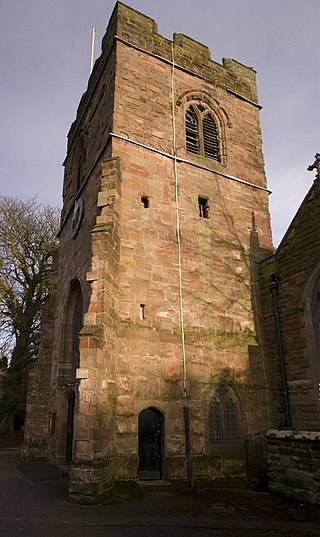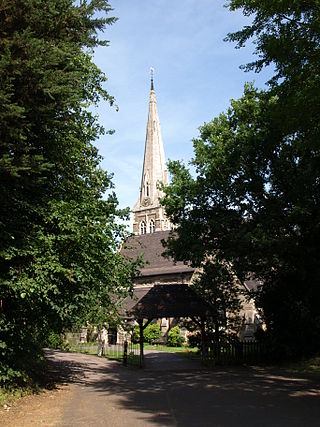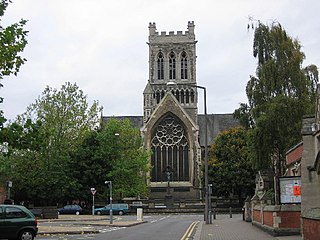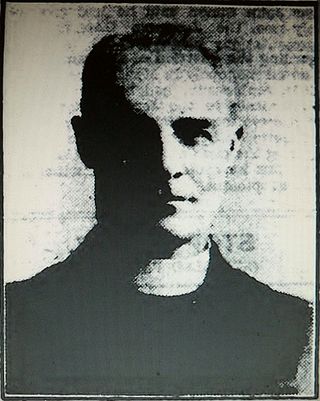
Robert William Dale was an English Congregational church leader based in Birmingham.

Westminster Chapel is an evangelical free church in Westminster, central London. The church is in Buckingham Gate, on the corner of Castle Lane and opposite the junction with Petty France. Buckingham Gate is just off Victoria Street and near Buckingham Palace.

St Mary's Church, Handsworth, also known as Handsworth Old Church, is a Grade II* listed Anglican church in Handsworth, Birmingham, England. Its ten-acre (4 hectare) grounds are contiguous with Handsworth Park. It lies just off the Birmingham Outer Circle, and south of a cutting housing the site of the former Handsworth Wood railway station. It is noteworthy as the resting place of famous progenitors of the industrial age, and has been described as the "Cathedral of the Industrial Revolution".

Austin Organs, Inc., is a manufacturer of pipe organs based in Hartford, Connecticut. The company is one of the oldest continuously-operating organ manufacturers in the United States. The first instruments were built in 1893 with the Austin Patent Airchest, and many remain in fine playing condition to this day.

Saint Peter's is the ancient parish church of Harborne, Birmingham, England.

St. Mary's Church, Selly Oak is a Church of England parish church in Selly Oak, Birmingham, England.

St Paul's Church is a Church of England parish church in Burton upon Trent, Staffordshire England. The church, on St Paul's Square and near the Town Hall, opened in 1874 and was designed by the architects James M. Teale and Edmund Beckett Denison. Later additions are by G. F. Bodley. The building is listed as Grade II*.

Rushworth and Dreaper was a firm of organ builders, and later general instrument suppliers associated with Paul McCartney based in Liverpool. The manufacturer was founded in 1828 by William Rushworth, operating until 2002. Upon its liquidation, its archives were mostly destroyed, and the Victorian clock in the works tower was removed. The premises are now occupied by Henry Willis & Sons.

St George's Church, Edgbaston, is a parish church in the Church of England in Edgbaston, Birmingham.

Charles Lloyd was a pipe organ builder based in Nottingham who flourished between 1859 and 1908.

Forster and Andrews was a British organ building company between 1843 and 1924.

James Jepson Binns was a pipe organ builder based in Leeds, West Yorkshire, England.

St Alban the Martyr, Birmingham is a Grade II* listed Church of England parish church in the Anglican Diocese of Birmingham. It is dedicated to Saint Alban, the first British Christian martyr.

St Peter's Church, Edensor, is a Grade I listed church in Edensor, Derbyshire. St Peter's is the closest parish church in the Church of England to Chatsworth House, home of the Dukes of Devonshire, most of whom are buried in the churchyard. St Peter's is in a joint parish with St Anne's Church, Beeley.

Reverend Joseph Miller BD was a Congregational minister, much in demand as an "eloquent preacher" for 14 years in the north of England. While in Hamburg during his ministry he "rendered valuable assistance to his countrymen in distress" following a call from the American Embassy there. However, in 1929 he "created a sensation" by becoming an Anglican priest. His first Anglican incumbency was as vicar of the Church of St Mark, Old Leeds Road, Huddersfield, England, from 1929 to 1931.

George Woodhouse was an English architect who practised from offices in Bolton, and Oldham, then in the county of Lancashire. He collaborated with William Hill on the designs for Bolton Town Hall.

Charles William Perkins was Birmingham City Organist from 1888 to 1923.

St George's Church, Kidderminster is a Church of England parish church in Kidderminster, Worcestershire, England. The church is a Grade II* listed building.

George Baines FRIBA was an architect based first in Accrington, Lancashire and then London who is known for designing many non-conformist chapels and churches.




















